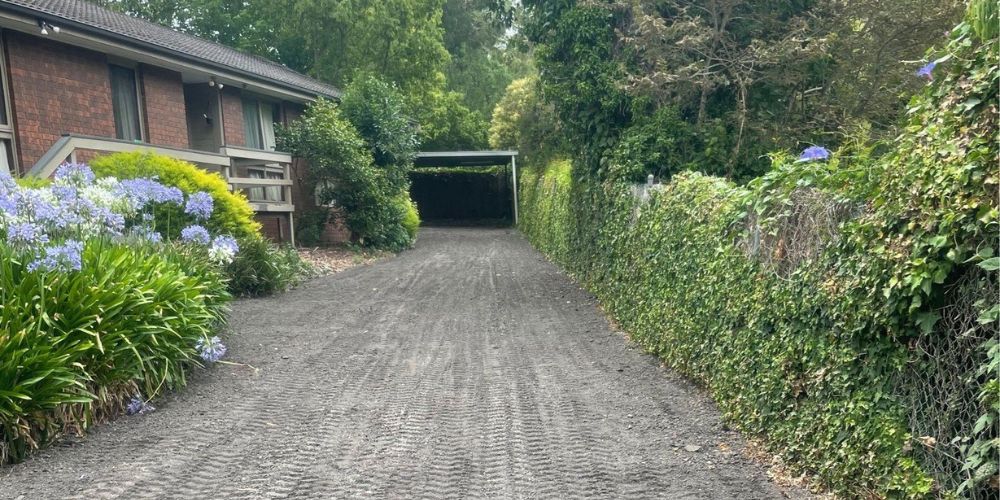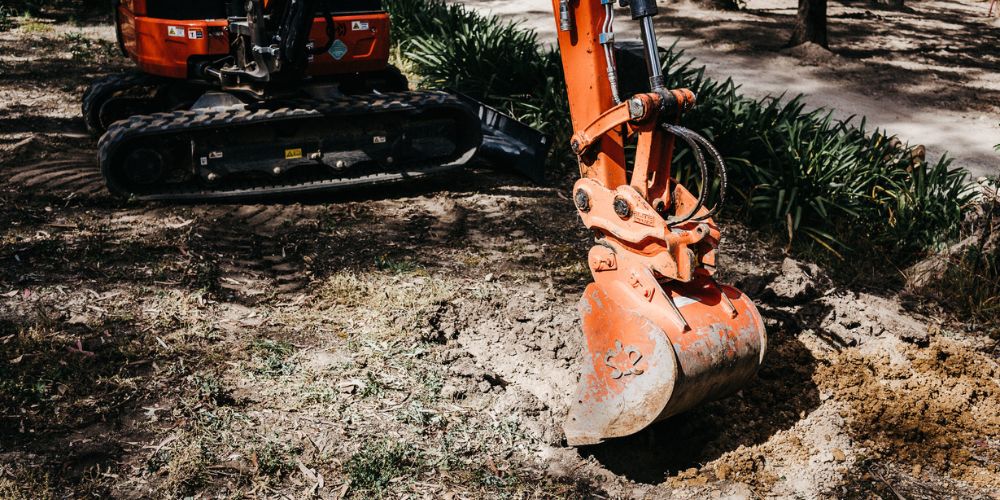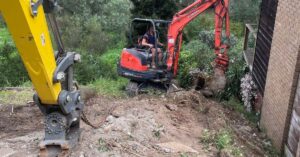Landscaping vs. Garden Design: How Do They Differ?
It is impossible to deny the appeal of a beautifully planned outdoor area. A well-designed outside space can improve any house’s visual appeal and practicality, whether it’s a serene garden sanctuary or a painstakingly groomed backyard. However, landscaping and garden design are the two main ways for constructing the ideal outdoor haven. Landscaping and garden design are not just about aesthetics. They greatly enhance your well-being, create a peaceful retreat, and connect you with nature.
But what is the difference between landscaping and creating garden designs?
In this blog, we’ll examine the differences between landscaping and garden design, allowing you to channel your inner artist and bring your outdoor idea to life. Join us as we, landscaping and excavation experts share our insights on how a landscape differs from a garden.
Let’s begin!

What is Landscaping?
Landscaping is the art and practice of improving the appearance and utility of outdoor spaces. It entails the planning, design, and execution of many aspects to convert a place into an aesthetically appealing and useful environment. Landscaping examples include plants, trees, bushes, flowers, lawns, paths, patios, decks, water features, and buildings such as gazebos or pergolas.
Landscaping aims to create a harmonious and balanced outdoor space that complements the surrounding architecture, maximizes the use of available land, and provides an enjoyable environment for various activities, such as relaxing, entertaining, or gardening. Landscaping can range from small-scale residential projects to large-scale commercial or public projects, and it often takes into consideration factors like climate, soil conditions, maintenance requirements, and the desired aesthetic style or theme.
Elements of Landscaping
Landscaping features are widely classified as softscape and hardscape components. Here’s some more information about each category:
Softscape
The living parts of landscaping, such as plants, trees, bushes, flowers, grass, and other vegetation, are called softscape. These features provide the outdoor environment with character, color, and vitality. Softscape design is selecting the appropriate plant species while considering their growth patterns, seasonal fluctuations, and care requirements. It also includes planting designs, flower beds, turf or grass installation, and incorporation of ground cover.
Hardscape
Hardscape refers to the non-living elements that determine the structure and operation of an outdoor space. Pathways, patios, decks, retaining walls, fences, gazebos, pergolas, water features (ponds or fountains), and outdoor structures such as sheds or play areas are all included. The arrangement, materials, and construction methods utilized for these components are the subject of hardscape design, which ensures longevity, accessibility, and aesthetic coherence with the entire landscape.
Landscapers create a visually pleasant outdoor setting by mixing softscape and hardscape features. The softscape adds life and beauty, while the hardscape adds structure and usefulness, resulting in a well-designed and cohesive environment.
Purpose of Landscaping
Landscaping serves several functions, including both aesthetic and practical features.
Here are some of the uses of landscaping on your property:
Improving Aesthetic Appeal
One of the fundamental goals of landscaping is to improve the aesthetics of outdoor spaces. Landscaping produces a visually appealing environment that adds beauty and curb appeal to homes, business spaces, and public places by carefully selecting and arranging plants, including beautiful hardscape components, and considering color palettes, textures, and focus points.
Creating a Friendly Environment
The goal of landscaping is to create a friendly and attractive environment. Well-designed landscapes can create feelings of serenity, relaxation, and enjoyment. They offer a location for outdoor activities, social events, and personal retreats, building a connection with nature and encouraging well-being.
Increasing Property Value
Landscaping is an investment that may dramatically boost a property’s value. A well-kept and visually appealing landscape makes a good first impression and can attract potential purchasers or tenants. It increases a property’s general marketability and appeal, leading to financial rewards in the long term.
Environmental Advantages
Landscaping is critical to environmental sustainability. Plants and trees contribute to better air quality by absorbing carbon dioxide and emitting oxygen. They also give shade, which helps to reduce energy usage by cooling the surrounding regions. Water conservation may be achieved by landscaping practices such as adequate irrigation, rainwater collecting, and using native plants that demand less water.
Usable Functionality
Landscaping serves more than simply aesthetic goals; it also serves practical functions. Landscape design may solve drainage, soil erosion, and slope stabilization concerns. It can designate specific places for various activities, such as leisure areas, play zones, or vegetable gardens. Pathways and patios, for example, promote accessibility and easy mobility within the outside space.
What Does Garden Design Actually Mean?
Designing, organizing, and constructing an aesthetically beautiful and practical garden environment is called garden design. Plant selection, layout, color palettes, themes, and integrating buildings and focal points are all important considerations.
Garden design is fundamentally about creating a unified and harmonious outdoor setting representing the garden owner’s unique style and preferences. It is more than just putting flowers and haphazardly arranging plants. Instead, it entails careful planning and intentional choices to produce the intended aesthetic and environment.
Key Aspects of Garden Design
Garden design involves numerous fundamental elements:
Choosing of Plants
A vital part of garden design is selecting the proper plants. Factors like color, texture, height, flowering season, and compatibility with the local climate are considered when choosing plants. The idea is to produce an attractive blend of plant species that complement one another and provide visual interest throughout the seasons.
Arrangement and Layout
The garden design depends on the layout and placement of plants and elements inside the garden space. Bedforms, routes, boundaries, and groups are all considered. Creating balance, symmetry, or rhythm by positioning various features helps the garden’s overall visual appeal and utility.
Themes and Color Schemes
The use of color is crucial in landscape design. A mood or style may be evoked in the garden by selecting a color palette or theme. The color scheme establishes the mood and improves the overall aesthetic, regardless of whether it is a sunny and colorful cottage garden, a peaceful and tranquil Zen garden, or a contemporary and minimalist design.
Arrangements and Focal Points
Structures and focal points are frequently used in garden design to add aesthetic appeal and practical components. Pergolas, arbors, water features, seating spaces, sculptures, or other ornamental components that act as garden focal points are examples of this. These structures and details provide the overall design depth, texture, and visual focus.
Seasonal Factors to Consider
The garden design maintains its aesthetic appeal yearly by accounting for the varying seasons. The garden may display its beauty and allure throughout the year by choosing various plants with distinct bloom timings, leaf colors, and textural characteristics.

Landscaping vs. Gardening Design: Key Differences
Garden design and landscaping are two different methods for constructing outdoor areas, each with a specific focus and goals. The following are the main distinctions between garden design and landscaping:
Scale and Range
Landscaping: The design and improvement of complete outdoor spaces, including lawns, gardens, and other elements like paths, patios, and structures, falls under the larger landscaping definition. It takes into account the room’s overall design and practicality.
Garden Design: Within the larger landscape, distinct garden sections are the focus of garden design. It focuses on constructing a unified and aesthetically beautiful garden area with a particular theme, style, or function. The aesthetics and configuration of the plants and other elements inside that specific space are more important considerations in garden design.
Elements of Emphasis
Landscaping: The emphasis on both softscape and hardscape components is increased in landscaping. It considers blending different living and non-living aspects, including structures, lawns, paths, patios, and water features. To create an outdoor environment that is both aesthetically pleasing and practical, these factors must be balanced.
Garden Design: The selection, organization, and composition of plants, flowers, and trees within the allotted garden space are among the soft scape components that are the main emphasis of garden design. It emphasizes using textures, color palettes, and visual harmony to generate a certain mood or style.
Size of the Project
Landscaping: Larger areas and specialized equipment may be needed for landscaping jobs and substantial installation. It may affect all or sizable property sections, necessitating a thorough strategy to change the landscape.
Garden Design: Most garden design projects are smaller in scope and concentrate on particular aspects of the landscape. They can be confined in certain outdoor spaces, such as courtyards or garden beds. Garden design projects may be easier to handle and enable more thorough consideration of the unique characteristics and aesthetics of the chosen garden space.
Design Method
Landscaping: The landscape design process frequently includes site investigation, appraisal, and planning. It considers elements, including soil properties, site circumstances, climate, and drainage. The landscape may need to be altered by construction and grading. The objective is to design an outdoor area that is useful, sustainable, and harmoniously blended with its surroundings.
Garden Design: Usually, creative and artistic planning elements are the main emphasis of garden design. The allocated garden space entails plant selection, spatial organization, and the development of visual focus points. The desired design, color scheme, seasonal appeal, and the garden’s unique subject or function are all considered throughout the design phase.
Can You Incorporate Landscape with Garden Designs?
Combining garden and landscape design effectively produces an integrated and beautiful outdoor setting. You may establish a pleasing balance between the larger environment and the particular garden parts using landscaping and garden design ideas.
Combining landscape and garden designs can achieve visual cohesion, improve aesthetics, ensure functional integration, achieve a harmonious balance, increase variety, ensure smooth transitions, expand design possibilities, encourage ecological balance, allow for individualization and creativity, and ultimately increase outdoor space enjoyment.
Frequently Asked Questions
Regular watering, correct trimming, fertilizing when required, mulching to manage weeds and conserve moisture, eyeing for pests and diseases, and routine cleaning and maintenance of hardscape elements are all examples of maintenance practices.
Consider aspects like your climate, sunshine exposure, soil type, care needs, intended aesthetic, and your garden’s specific goal or theme when choosing plants.
Reduce the amount of lawn space, add native plants suitable to your environment, utilize controlled watering systems, construct weed barriers, and consider adding low-maintenance hardscape elements like gravel walks or pavers to reduce care.
Using tall trees, hedges, or climbing plants to provide natural screens, erecting fences or trellises, including privacy walls or partitions, or arranging outdoor furniture or plants in strategic locations to create private spaces are all ways to enhance privacy.
Conclusion
Garden design and landscaping are two different things. Landscaping combines living and non-living components to design a beautiful outdoor area. It’s like using the earth as your canvas to create art. On the other hand, the art of layout, color, and texture are fundamental to garden design. It’s about designing a room that represents your particular taste and creates the atmosphere for peaceful and creative moments.
Understanding the intricate details of landscaping and garden design may help you make educated decisions about your outdoor environment. By studying these techniques ‘ major distinctions and similarities, you may balance the general layout, hardscape features, and the visual harmony of plants and garden aesthetics. Furthermore, combining landscaping and garden design ideas may provide a more unified and appealing outdoor setting.

Share on facebook Facebook Share on twitter Twitter Share on linkedin LinkedIn Share on whatsapp WhatsApp Table of Contents When starting a construction or landscaping project, one of the first questions people ask is, “How long will it take?” Excavation is a critical first step in many projects, setting the foundation (literally) for everything that

Share on facebook Facebook Share on twitter Twitter Share on linkedin LinkedIn Share on whatsapp WhatsApp Table of Contents When you think about excavation, you probably imagine a well-planned project where the site is prepared, utilities are marked, and every detail is carefully mapped out. But not all excavations have the luxury of time. Sometimes,

Share on facebook Facebook Share on twitter Twitter Share on linkedin LinkedIn Share on whatsapp WhatsApp Table of Contents As someone who has spent years designing and building gardens and retaining walls, I’ve often seen homeowners mix the two. While they may seem like similar structures at first glance, each serves a distinct purpose. Using
